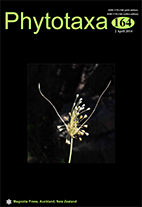Abstract
Phylogenies of Ceriporiopsis and related genera were studied using DNA sequences from the ITS+28S nuclear ribosomal RNA gene regions. Two species, Ceriporiopsis alboaurantia and C. semisupina, are described as new to science. Ceriporiopsis alboaurantia is characterized by annual growth habit, resupinate basidiocarps with white pore surface when fresh, turning to apricot-orange to dark orange upon drying, monomitic hyphal system with clamped generative hyphae encrusted with pale yellow crystals, ellipsoid and thin-walled basidiospores (4–5 ´ 3–3.3 µm), and plenty of pale-yellow to pale-orange oily substances in subiculum and trama. Ceriporiopsis semisupina is distinguished by annual, effused-reflexed basidiocarps with greyish brown to reddish brown pore surface, monomitic hyphal system with clamped generative hyphae bearing crystalline incrustation, long-clavate basidia, ellipsoid and thin-walled basidiospores (4–4.5 ´ 3–3.3 µm). Like previous study, the phylogenetic analysis presented here also showed that Ceriporiopsis is not monophyletic and the sampled species were grouped in four clades, including phlebia clade, residual polyporoid clade, tyromyces clade and gelatoporia clade.

